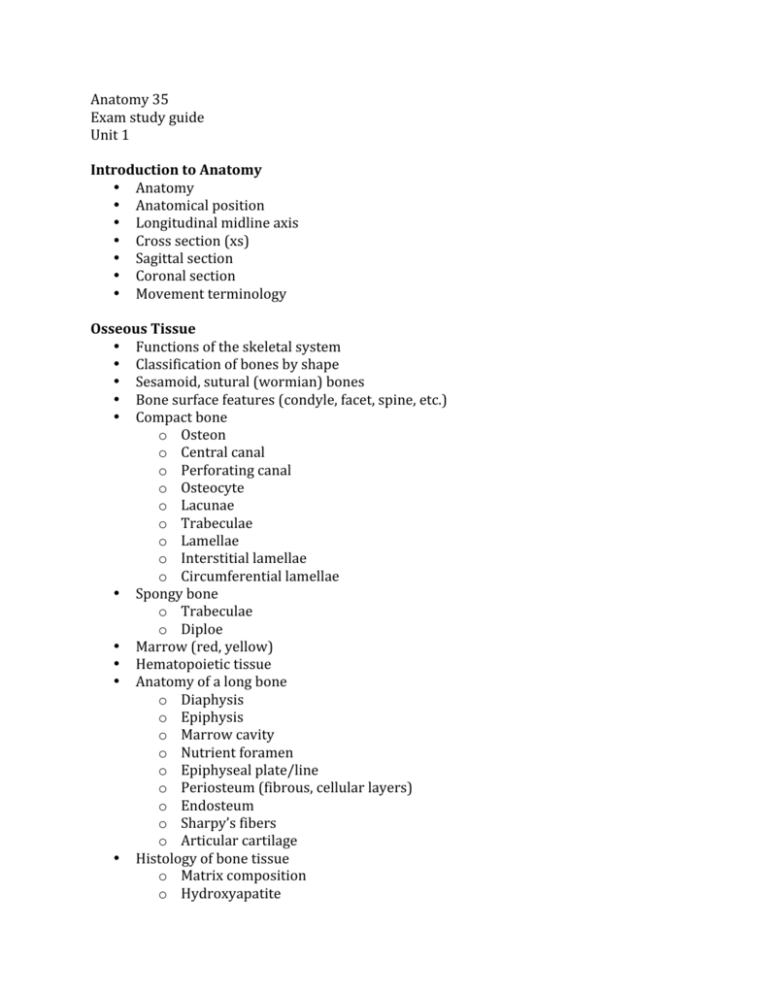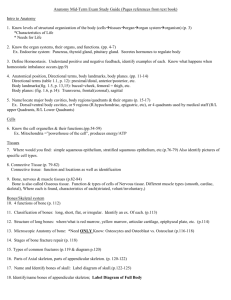Anatomy 35 Exam study guide Unit 1 Introduction to Anatomy
advertisement

Anatomy 35 Exam study guide Unit 1 Introduction to Anatomy • Anatomy • Anatomical position • Longitudinal midline axis • Cross section (xs) • Sagittal section • Coronal section • Movement terminology Osseous Tissue • Functions of the skeletal system • Classification of bones by shape • Sesamoid, sutural (wormian) bones • Bone surface features (condyle, facet, spine, etc.) • Compact bone o Osteon o Central canal o Perforating canal o Osteocyte o Lacunae o Trabeculae o Lamellae o Interstitial lamellae o Circumferential lamellae • Spongy bone o Trabeculae o Diploe • Marrow (red, yellow) • Hematopoietic tissue • Anatomy of a long bone o Diaphysis o Epiphysis o Marrow cavity o Nutrient foramen o Epiphyseal plate/line o Periosteum (fibrous, cellular layers) o Endosteum o Sharpy’s fibers o Articular cartilage • Histology of bone tissue o Matrix composition o Hydroxyapatite o Osteoprogenitor cells o Osteoblasts o Osteocytes o Osteoclasts o Bone lining cells • Osteogenesis • Mesenchyme • Endochondral bone formation o Primary, secondary center of ossification o Interstitial growth o Appositional growth • Intramembranous bone formation Appendicular Skeleton • Know the components of the appendicular skeleton • Name and location of every bone • Know all of the bone markings (listed in your lab manual) • Know how every bone articulates with other bones • Know components of the girdles • Know the components of the limbs o Upper limb: brachium, antebrachium, carpals, metacarpals, phalanges o Lower limb: thigh, leg, tarsals, metatarsals, phalanges • Sexual dimorphism of the pelvic girdle • Arches of the foot • Dorsum of the foot (why is the top called the dorsum?) • Plantar surface of the foot (why is the bottom called the plantar surface?) Axial Skeleton • Know the components of the axial skeleton • Know all of the bones of the skull o Cranial bones o Facial bones • Know all of the bone markings (listed in your lab manual) • Know the cranial fossae • Know the cavities of the skull • Know the paranasal sinuses of the skull • Know the foramina of the skull (listed in your lab manual, plus the bone that they lie in. For foramina that exist as a junction of 2 or more bones, you need to know the bones involved) • Know the ear ossicles and how they articulate • Know the components of the vertebral column • Know the functions of the vertebral column • Know the spinal curvatures • Know each kind of vertebra, the features that all vertebra share and any unique features they might have based on their location • Know the anatomy of the intervertebral discs • • • • • • • • • • • • • Know how the vertebra articulate together Know the components of the thoracic cage Know the functions of the thoracic cage Know the differences between a true rib, a false rib and a floating rib Articulations Know the criteria for classifying joints Know the different categories of joints as well as specific examples o Synarthrosis (suture, schidylesis, gomphosis, synchondrosis) o Amphiarthrosis (symphysis, syndesmoses) o Diarthrosis (hinge, gliding, pivot, saddle, condyloid, ball and socket) Know characteristics of synovial joints. Know all of the structures of a synovial joint and their function Know the components of synovial fluid, what secretes it and the functions of it Know movement terminology Know the components of a lever system Know each type of lever and be able to give an example Know which joint has increased leverage or speed Histology • Know the definition of histology • Know the planes of section • Know the 4 basic tissue types and how they are classified • Know the composition and function of each type of tissue. Be able to give examples of where a type of tissue is found • Know what cilia are, where they are found and their function • Know the components of connective tissue and the characteristics of the different types of connective tissue and examples of where they are found • Know the characteristics of nervous tissue • Know the characteristics of muscle tissue and the 3 types Integument • Components of the integument (epidermis, dermis, hypodermis) • Accessory structures (hair, nails, cutaneous glands) • Functions of the integument • Thick skin versus thin skin • Characteristics of the layers of the epidermis o Stratum corneum, lucidum, granulosum, spinosum, basale • Epidermal cell types o Keratinocytes, melanocytes, merkel cells, Langerhans cells • Dermis o Names and characteristics of the layers of the dermis • Hypodermis • Human skin pigments o Melanin, carotene, hemoglobin • Epidermal derivatives o Hair (hair follicle, sebaceous gland, arrector pili muscle) Function of hair Types of hair Anatomy of hair o Nails (eponichium, hyponichium, lunula, nail body, root) o Glands Endocrine glands Exocrine glands Goblet cells Acinis, duct Classification by duct structure Branching patterns Merocrine secretion Apocrine secretion Holocrine secretion Apocrine sweat glands Eccrine sweat glands Ceruminous glands Sebaceous glands Mammary glands







